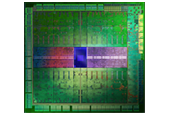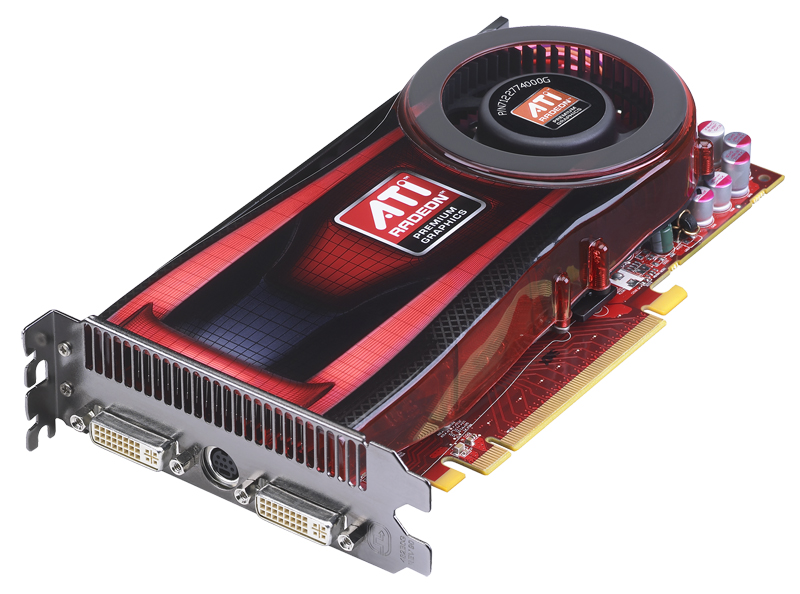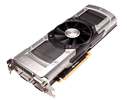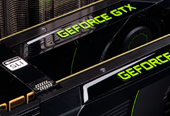A video card (also called a video adapter, display card, graphics card, graphics board, display adapter or graphics adapter and sometimes preceded by the word discrete or dedicated to emphasize the distinction between this implementation and intergrated graphics card) is an expansion card which generates a feed of output images to a display (such as a computer monitor). Within the industry, video cards are sometimes called graphics add-in-boards, abbreviated as AIBs,[1] with the word "graphics" usually omitted. Virtually all current video cards are built with either AMD-sourced or Nvidia-sourced graphics chips.[1] Most video cards offer various functions such as accelerated rendering of 3D scenes and 2D graphics, MPEG-2/MPEG-4 decoding, TV output, or the ability to connect multiple monitors (multi-monitor).
Combining the power of two Kepler GPUs, the GeForce GTX 690 is the fastest graphics card ever built.
Features Of NVIDIA GeForce GTX 690
 NVIDIA's Kepler GPU architecture has been designed from the ground up
not just for maximum performance in the latest DirectX 11 games, but
optimal performance per watt. The new SMX streaming multiprocessor is
twice as efficient as the prior generation and the new geometry engine
draws triangles twice as fast. The result is world class performance and
the highest image quality in an elegant and power efficient graphics
card.
NVIDIA's Kepler GPU architecture has been designed from the ground up
not just for maximum performance in the latest DirectX 11 games, but
optimal performance per watt. The new SMX streaming multiprocessor is
twice as efficient as the prior generation and the new geometry engine
draws triangles twice as fast. The result is world class performance and
the highest image quality in an elegant and power efficient graphics
card.
 Nothing is more distracting than framerate stuttering and screen
tearing. The first tends to occur when framerates are low, the second
when framerates are high. Adaptive V-Sync is a smarter way to render
frames. At high framerates, V-sync is enabled to eliminate tearing, at
low frame rates, it's disabled to minimize stuttering. It gets rid of
distractions so you can get on with gaming.
Nothing is more distracting than framerate stuttering and screen
tearing. The first tends to occur when framerates are low, the second
when framerates are high. Adaptive V-Sync is a smarter way to render
frames. At high framerates, V-sync is enabled to eliminate tearing, at
low frame rates, it's disabled to minimize stuttering. It gets rid of
distractions so you can get on with gaming.
 Nothing is as breathtaking as playing your favorite games across
three monitors. At 5760 x 1080, the expanded field of view fully engages
human peripheral vision and provides for the most immersive experience
in racing and flight simulators. Add in a fourth display to keep tabs on
chat, email or web while you are gaming. Two New Anti-aliasing Modes: FXAA and TXAA
Nothing is as breathtaking as playing your favorite games across
three monitors. At 5760 x 1080, the expanded field of view fully engages
human peripheral vision and provides for the most immersive experience
in racing and flight simulators. Add in a fourth display to keep tabs on
chat, email or web while you are gaming. Two New Anti-aliasing Modes: FXAA and TXAA
The second mode, TXAA, is an in-game option that combines MSAA, temporal filtering, and post processing for even higher visual fidelity.
NVIDIA GTX TITAN Z
vidia are currently on-stage at the GPU Technology Conference (think GDC for people who really love cores). They've just announced the GeForce GTX Titan Z, a $3,000 dual-Keplar GPU graphics card that can supercharge PCs with a total of 5,760 processing cores, and 12GB frame buffer memory. To my untrained eye, then, it essentially sounds like two Titan Blacks duct taped together. I'm sure that in practice it's a little bit more complicated.
A press release from Nvidia explains why their dual-GPU solution is such an attractive prospect for super-high def gaming. "Unlike traditional dual-GPU cards, Titan Z’s twin GPUs are tuned to run at the same clock speed, and with dynamic power balancing. So neither GPU creates a performance bottleneck. And that performance is delivered in a card that is cool and quiet, rather than hot and loud. Low-profile components and ducted baseplate channels minimize turbulence and improves acoustic quality."
However they're tuned, it's a serious amount of money. A single GTX Titan can be secured for around $1,000, so you'll be a paying a heavy premium for Nvidia's tweaking. The company say they're building the Titan Z for "next-generation 5K and multi-monitor gaming", so are clearly targeting those prepared to go large in their home rig.
The announcement comes ahead of AMD's own dual-GPU reveal, which is expected to be made later this week.
NVIDIA GeForce GTX 690
Features Of NVIDIA GeForce GTX 690
Kepler GPU Architecture
 NVIDIA's Kepler GPU architecture has been designed from the ground up
not just for maximum performance in the latest DirectX 11 games, but
optimal performance per watt. The new SMX streaming multiprocessor is
twice as efficient as the prior generation and the new geometry engine
draws triangles twice as fast. The result is world class performance and
the highest image quality in an elegant and power efficient graphics
card.
NVIDIA's Kepler GPU architecture has been designed from the ground up
not just for maximum performance in the latest DirectX 11 games, but
optimal performance per watt. The new SMX streaming multiprocessor is
twice as efficient as the prior generation and the new geometry engine
draws triangles twice as fast. The result is world class performance and
the highest image quality in an elegant and power efficient graphics
card.NVIDIA GPU Boost
Up until now, GPUs have operated at a fixed clock speed when playing 3D games, even if they have the potential to run faster. GPU Boost intelligently monitors graphics work load and increases the clock speed whenever possible. The result is that the GPU always performs at its peak and you get the highest framerate possible.NVIDIA Adaptive Vertical Sync
 Nothing is more distracting than framerate stuttering and screen
tearing. The first tends to occur when framerates are low, the second
when framerates are high. Adaptive V-Sync is a smarter way to render
frames. At high framerates, V-sync is enabled to eliminate tearing, at
low frame rates, it's disabled to minimize stuttering. It gets rid of
distractions so you can get on with gaming.
Nothing is more distracting than framerate stuttering and screen
tearing. The first tends to occur when framerates are low, the second
when framerates are high. Adaptive V-Sync is a smarter way to render
frames. At high framerates, V-sync is enabled to eliminate tearing, at
low frame rates, it's disabled to minimize stuttering. It gets rid of
distractions so you can get on with gaming.NVIDIA 3D Vision® Ready1
NVIDIA 3D Vision brings a fully immersive, stereoscopic 3D experience to the PC. A combination of high-tech wireless glasses and advanced software, 3D Vision transforms hundreds of PC games into full stereoscopic 3D. Get up to 2x monitor and keyboard brightness with NVIDIA 3D LightBoost technology4. In addition, you can enjoy 3D movies and 3D digital photographs from 3DVisionLive.com in eye popping, crystal-clear quality.NVIDIA Surround with Up To Four Monitors2
 Nothing is as breathtaking as playing your favorite games across
three monitors. At 5760 x 1080, the expanded field of view fully engages
human peripheral vision and provides for the most immersive experience
in racing and flight simulators. Add in a fourth display to keep tabs on
chat, email or web while you are gaming. Two New Anti-aliasing Modes: FXAA and TXAA
Nothing is as breathtaking as playing your favorite games across
three monitors. At 5760 x 1080, the expanded field of view fully engages
human peripheral vision and provides for the most immersive experience
in racing and flight simulators. Add in a fourth display to keep tabs on
chat, email or web while you are gaming. Two New Anti-aliasing Modes: FXAA and TXAAAnti-aliasing smoothes out jagged edges but can be demanding on framerates. FXAA is a new antialiasing technology that produces beautiful smooth lines with minimal performance impact. And with Kepler based GPUs, you'll be able to enable FXAA in hundreds of game titles through the NVIDIA Control Panel.
The second mode, TXAA, is an in-game option that combines MSAA, temporal filtering, and post processing for even higher visual fidelity.
NVIDIA Quad SLI® Technology3
Used by the most demanding gamers worldwide, Quad SLI lets you link up to two GeForce GTX 690s together for astounding performance. And with NVIDIA's track record for fast and frequent software updates, you'll not only get the best performance in existing games, but future games too.
NVIDIA PhysX® Technology
Full support for NVIDIA PhysX technology, enabling a totally new class of physical gaming interaction for a more dynamic and realistic experience with GeForce.
NVIDIA GTX TITAN Z
vidia are currently on-stage at the GPU Technology Conference (think GDC for people who really love cores). They've just announced the GeForce GTX Titan Z, a $3,000 dual-Keplar GPU graphics card that can supercharge PCs with a total of 5,760 processing cores, and 12GB frame buffer memory. To my untrained eye, then, it essentially sounds like two Titan Blacks duct taped together. I'm sure that in practice it's a little bit more complicated.
A press release from Nvidia explains why their dual-GPU solution is such an attractive prospect for super-high def gaming. "Unlike traditional dual-GPU cards, Titan Z’s twin GPUs are tuned to run at the same clock speed, and with dynamic power balancing. So neither GPU creates a performance bottleneck. And that performance is delivered in a card that is cool and quiet, rather than hot and loud. Low-profile components and ducted baseplate channels minimize turbulence and improves acoustic quality."
However they're tuned, it's a serious amount of money. A single GTX Titan can be secured for around $1,000, so you'll be a paying a heavy premium for Nvidia's tweaking. The company say they're building the Titan Z for "next-generation 5K and multi-monitor gaming", so are clearly targeting those prepared to go large in their home rig.
The announcement comes ahead of AMD's own dual-GPU reveal, which is expected to be made later this week.















0 comments:
Post a Comment